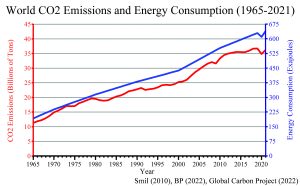The AI Revolution Is Bad News for Net Zero
By Steve Goreham
Artificial intelligence (AI) is taking the world by storm. New AI applications are announced daily. Amazon, Apple, Google, Meta, Microsoft, and many companies tout plans for artificial intelligence capabilities. But the AI revolution is bad news for global efforts to achieve net-zero emissions.
The AI revolution is based on high-performance AI chips, which are capable of revolutionary levels of computer processing power and capable of sorting through vast amounts of stored data. Multiple AI chips reside on each of dozens of boards, housed in endless racks of servers, which are sited in warehouse-sized AI data centers. While the rack of a conventional server of a data center draws roughly seven kilowatts of electricity, an AI server rack can use up to 50 kilowatts of power.
Spending on artificial intelligence infrastructure is projected to grow at a compound annual rate of 44% over the next six years. Total data center power requirements will increase by at least a factor of six and maybe by as much as 10 times by 2029. Greenhouse gas emissions from AI data centers will increase by similar amount.
The International Energy Agency estimates that data centers account for 1-1.5 percent of world electricity use and are responsible for about one percent of energy-related greenhouse gas emissions. But the rapid growth of AI infrastructure, coupled with a jump in electricity consumption as power-hungry AI server racks replace conventional server racks, will cause carbon dioxide (CO2) emissions from data centers to skyrocket. Artificial intelligence will become a major contributor to global CO2 emissions by 2030, contrary to Net Zero goals.
Proponents define Net Zero as a zero balance between the amount of greenhouse gases emitted from human industrial processes and the amount removed from the atmosphere. They claim that Net Zero must be attained by 2050 to limit the rise in global temperatures to 1.5oC above the background temperature level of the 1800s. Wind turbines, solar panels, heat pumps, biofuels, hydrogen fuel, and carbon dioxide capture and storage are all promoted as vehicles to get to Net Zero.
But virtually nothing that our modern society does is “zero emissions.” If you build a house, sizeable greenhouse gases are emitted by cutting down trees for producing lumber, mining materials and manufacturing wire and components for electricity, producing plastic or copper for pipes, manufacturing drywall, roofing, brick, glass, concrete, and many other materials. Manufacturing of household furnishings, such as furniture, appliances, and computers, also emits large quantities of CO2. Transportation of all these materials emits greenhouse gases. Even a grass hut isn’t Net Zero. CO2 is released when you cut down grass and wood to build the hut.
Net Zero is fundamentally a zero-growth ideology. The United Nations, the International Energy Agency, and green leaders call for an eight percent reduction in world energy consumption by 2050. But energy consumption increased 47 percent from 2000 to 2021. They call for a 40 percent reduction in carbon dioxide emissions by 2030. But global CO2 emissions increased by 44 percent from 2000 to 2021. The AI revolution and other programs for societal development run contrary to the zero-growth plans of Net Zero.

Today, about 700 million people do not have access to electricity. Another two billion people suffer from daily electrical power blackouts. If your home in the United States has an air conditioner, you consume triple the electricity that is used by people in one-third of Earth’s population. Net Zero demands for a global reduction in energy use run counter to history and common sense.

Far away from artificial intelligence, the residents of developing nations lack many things that we take for granted in wealthy nations. People in the US and Europe enjoy at least one vehicle for every two residents, compared to fewer than four vehicles per 100 people in India and Africa. In sub-Saharan Africa, where daily temperatures often exceed 86oF (30oC), only one in sixteen people has air conditioning. Forty percent of these people don’t even own a fan. As another example, residents in wealthy countries use about 20 times as much plastic as residents in undeveloped countries. The people of developing nations will choose economic growth over the no-growth policies of Net Zero.
Driven by the expansion of new technologies such as artificial intelligence and the need for economic growth in developing countries, there is zero chance that Net Zero will be achieved by 2050. Energy consumption and CO2 emissions will continue to rise for decades to come.
This commentary was originally published at Daily Caller on September 21, 2023.
CO2 Coalition Member Steve Goreham is a speaker on energy, the environment, and public policy and the author of the new bestselling book Green Breakdown: The Coming Renewable Energy Failure.
Editor’s Note: As administrators of the CO2 Coalition website, we are obliged to state that increases in CO2 emissions from the expansion of AI infrastructure, or anything else, will be beneficial. Research in recent years has established that both humanity and ecosystems are thriving because of greater fertilization of plants from an increased concentration of CO2, 300 years of natural warming following the Little Ice Age and the use of fossil fuels. We love CO2 and so should you.
